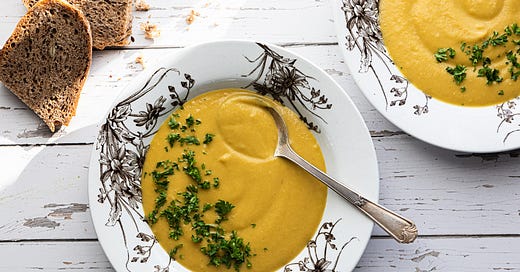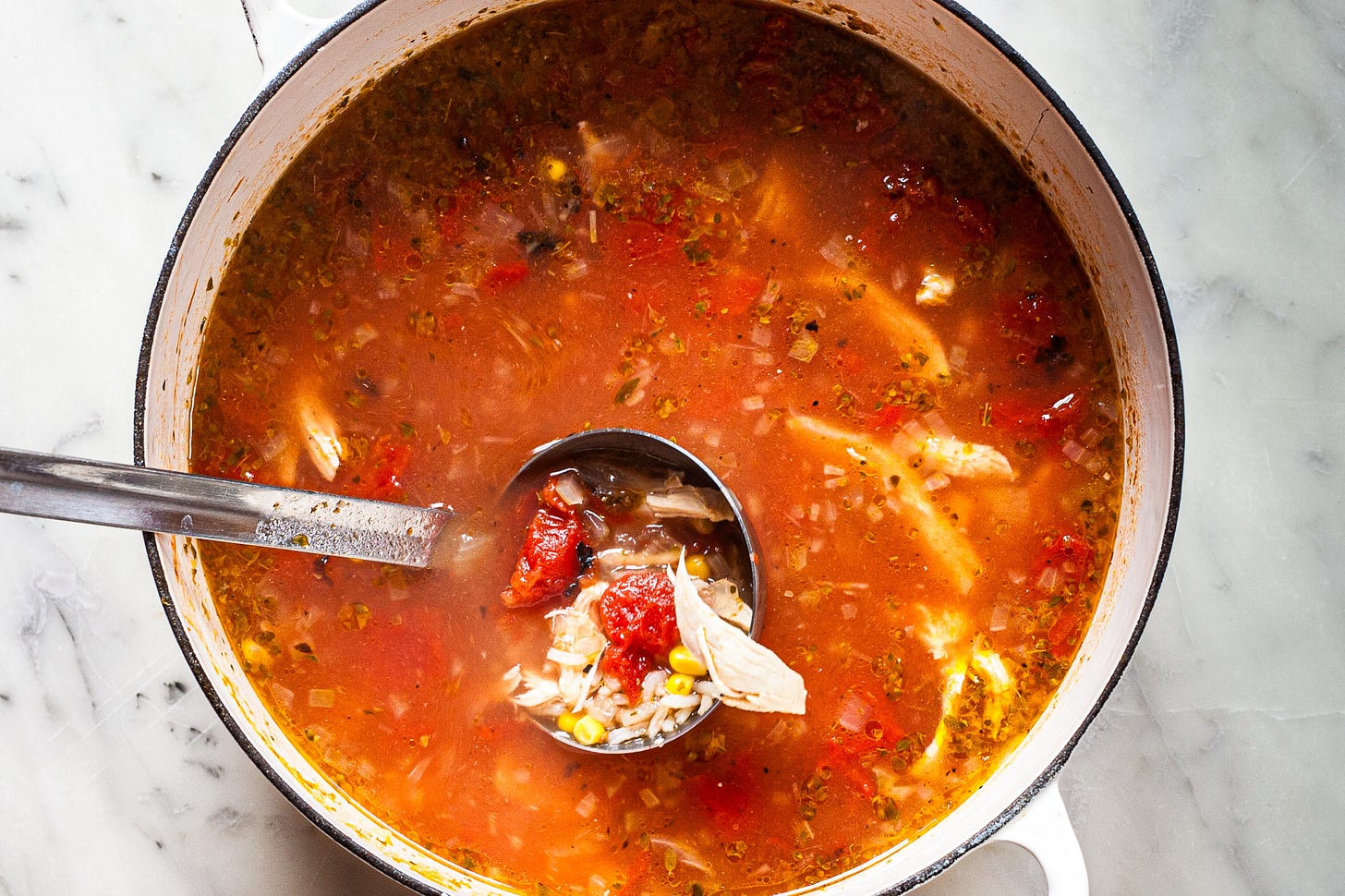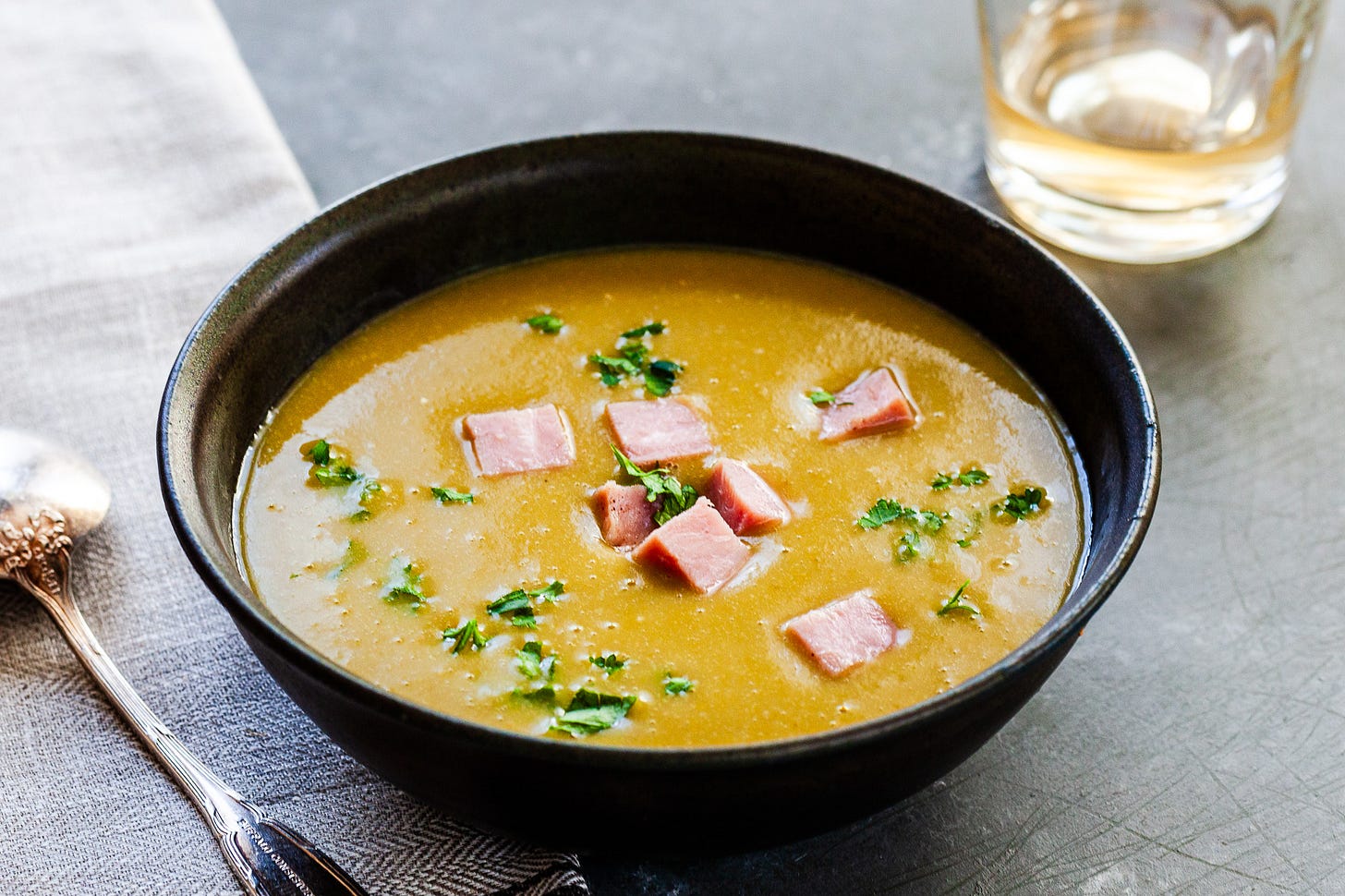If you’re new here, welcome! I hope the recipes I share and the little lessons along the way will make your cooking (and life) easier. With so many Substacks now, I understand it’s hard to support everyone. Never fear. There’s plenty here that is free. To those of you who have chosen to part with a some pieces of green on my behalf, thank you from the bottom of my heart. You’ll find recipe updates in the index, all downloadable and ready to print. My cookbook links here and a link to older recipes here. My former blog was having a nervous breakdown, so I ended up on Substack. I hope you’ll join me.
************************
I don’t really want to talk about winter. Or the whiplash many of us are experiencing from the messy world outside. Because I’m trying my best not to complain, at least not to you. I don’t think you came here for my rants.
But we can’t deny that the fickle finger of fate is pointing us in an uncomfortable direction right now. There is (unsubstantiated) proof that it won’t help to hide under the covers when things get dicey. Besides, ever has it been this way. We forgot. Waxing and waning , the world keeps spinning. It’s just gotten a bit louder. But we have to keep going.
Meanwhile, let’s make soup. Large steamy pots of deliciousness mean there will be plenty to share. Drop off the extra to a loved one. It’s like extending a much-needed hug to a friend. So be sure to reserve some for a person in need of it. Um, that might be everyone.
I’ve got three winter soups to add to my collection so far (see index for more.) The first is my latest ever-changing version of good ol’ comforting Split Pea Soup. Then there’s my mother-in-law’s Chicken Soup with a Mexican twist, and finally, a winter adaptation of the Roasted Tomato Soup that I usually make in September with fresh tomatoes. I’ve added white beans to give it some heft and used canned tomatoes instead of fresh. The result is a creamy-no-cream soup with deep, concentrated tomato flavors, just what you crave when it’s cold outside and you have grilled cheese on your mind.
There’s a lot to slurp here, so let’s get going.
Things to Know About Soup
Most soup recipes make more than enough for 4 servings, but here’s the good news: those large quantities are the gateway to batch cooking for….Weeknights! No effort! Meals without wheels (as in, no schlepping and shopping required!) Have I got some tips for you, friends! Make it now, eat some of it much later (freeze!), instead of every single night until it’s gone.
How to store soup:
• Fridge: about 5 days
• Freezer: 3 months for soups, 6 months for clear stock
• Containers: BPA-free plastic containers with lids, tempered glass jars, or sturdy plastic zipper bags.
How to freeze soup:
• Let it cool completely before transferring it to containers. Plastic freezer bags are genius if you have limited freezer space—doesn’t everyone have limited freezer space? Fill sturdy quart-size zipper plastic bags. Press out as much air as you can and seal the bags. Stack them flat in the freezer (on a small baking sheet or square baking pan). Once they are frozen, you can stand them upright (like books) or stack them flat (like sweaters.)
• Label and date: Don’t be a slouch. You have enough mystery ingredients in there. Use this tape and a sharpie.
A few caveats re: freezing soup:
• Soup with rice, other grains, and pasta don’t freeze well because they absorb most of the liquids when they sit in the broth. If you’re making a big batch to freeze, omit the starchy elements and freeze. Then cook the starch separately and add when you reheat the soup just before serving.
• Potato soups tend to turn gummy in the freezer, so don’t make huge batches unless you can give them away.
• Some soups separate after freezing (like this carrot ginger soup). There’s an easy to remedy for that. A quick blitz in a blender and all is good again.
How to thaw soup: Thaw overnight in the fridge (as if) or heat in a saucepan over low heat. You can also immerse the plastic bags in warm water and wait. I’m way too impatient for that.
How to blend hot soup:
I personally prefer a countertop blender that sits on a base to a stick (immersion) blender. I think it does a much better job if you’re going for the smoothest possible texture. You could wait around for the soup to cool, but if you’re a one-and-done sort of person, you can go ahead and blend hot soup with these caveats. To prevent exploding soup, do NOT overfill the blender; halfway is the best strategy. Make sure the lid is on securely (duh) and place a dishtowel on top of it. Start blending on the lowest setting and gradually increase the speed.
Here are three soups that will keep you warm this winter.
Split Pea Soup
Makes 12 cups | Prep time: 10-15 minutes | Cook time: 45 to 55 minutes
I change my mind a lot, especially when it comes to recipes. This is my latest version of split pea soup—it doesn’t stray too far off the beaten path from traditional split pea soup, but I’ve omitted the ham bone and added more vegetables and Parmesan. It makes a great vegetarian (not vegan) alternative to one with ham. For a vegan recipe, just omit the Parmesan. You don’t necessarily need to use stock unless you have some that you want to use up. The vegetables in the soup give it plenty of flavor.
INGREDIENTS
2 tablespoons olive oil or unsalted butter
1 medium onion, diced
2 medium carrots, sliced
2 ribs celery, sliced
1/2 teaspoon dried thyme
1 medium potato (any kind), peeled and diced
1 1/2 cups split peas (12 ounces)
8 cups chicken stock, vegetable stock, or water
Salt and pepper, to taste
1/2 cup finely grated Parmesan
1 cup diced ham (optional)
METHOD
1. In a large pot (5 to 6 quarts) over medium heat, heat the oil or butter. Add the onion, carrot, celery, and thyme. Sauté for 3 to 4 minutes, or until the onions start to soften.
2. Add the potatoes, split peas, and stock or water to the pot. Bring to a boil and adjust the heat to a steady simmer. Simmer for 45 to 50 minutes, or until the peas are falling apart.
3. Transfer the soup to the blender in 2 or 3 batches, taking care to fill the blender only halfway if the soup is hot. Add the Parmesan to one of the batches. Blend until smooth and transfer to a pot. Taste and add more salt and pepper if you like.
TIPS AND TWEAKS
Substitutions: Use yellow split peas instead of green. Add more vegetables if you like or throw a ham bone into the pot. You could probably substitute red or brown lentils, too if that’s what you have. (I still favor the green split peas.)
Quantity: You can cut the recipe in half, but why would you? Parcels of the soup in your freezer await you for when you really don’t feel like cooking anything. Just make some toast!
Seasonings: Ham bone (as mentioned). Different herbs such as bay leaves (remove before blending), parsley, chives, dill, tarragon, sage, oregano—basically, you name it but don’t go overboard. What sounds good to you? Middle Eastern spin: cinnamon, coriander, cumin, Baharat, sumac, turmeric, Za’atar.
Make Ahead: See how to store and freeze, above. No special instructions: this one freezes well.
Vegetarian: use vegetable stock or water
Vegan: Omit the Parmesan
Instant Pot or Pressure Cooker: (a good ‘set it and forget it move’)
1. Select the sauté setting. Heat the oil and add the onion, carrot, celery, and thyme. Sauté for 3 to 4 minutes, or until the onions start to soften.
2. Add the potatoes, split peas, and stock or water to the pot. Secure the lid. Cancel the sauté setting and turn on the soup/broth setting. Set timer for 15 minutes at high pressure. Allow the pressure to release naturally.
3. Transfer the soup to the blender in 2 or 3 batches, taking care to fill the blender only halfway if the soup is hot. Add the Parmesan to one of the batches. Blend until smooth and transfer to a pot. Taste and add more salt and pepper if you like.






